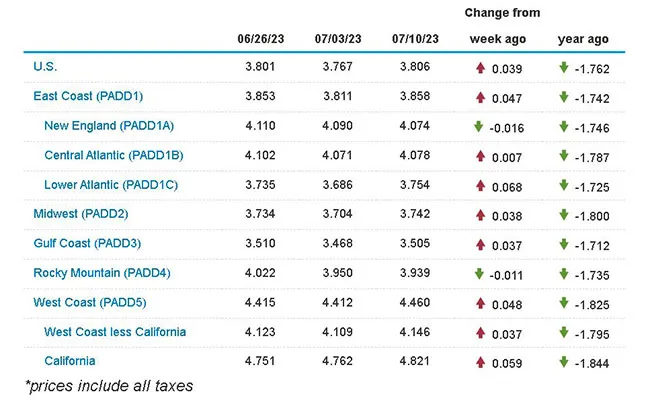Staff Reporter
Diesel Prices Jump an Average of 3.9¢ to $3.806 a Gallon

[Stay on top of transportation news: Get TTNews in your inbox.]
On-highway diesel prices climbed 3.9 cents to a national average of $3.806 a gallon, according to Energy Information Administration data released July 10.
The diesel price increase was just the sixth of the year. Of the other five, three occurred in January, one on April 17 and one on June 19.
More are expected, however, as wholesale diesel prices continue to rise and supply-side factors continue to offer support, analysts say.
The current increase was the second largest of 2023, trailing only an 8-cent surge Jan. 23.
U.S. average on-highway #diesel fuel price on July 10, 2023 was $3.806/gal, UP 3.9¢/gallon from 7/03/23, DOWN $1.762/gallon from year ago #truckers #shippers #fuelprices https://t.co/lPvRNZG7iO pic.twitter.com/wj1gkcoVQE — EIA (@EIAgov) July 11, 2023
Diesel prices on average across the U.S. are down $1.762 a gallon from this time last year.
Of the 10 regions in EIA’s weekly survey, the average diesel price rose in eight and fell in two. The largest increase was 6.8 cents per gallon in the Lower Atlantic; the biggest decline was 1.6 cents in New England.
Retail prices are finding support from the wholesale market. Front-month ultra-low-sulfur-diesel futures prices confirmed support at $2.40 a gallon over the past week and have threatened to breach upside resistance in a $2.60 to $2.65-a-gallon range.
Crude price strength is behind the increase in wholesale diesel prices, and therefore retail prices, Wood Mackenzie Vice President of Refining, Chemicals & Oil Markets Alan Gelder said in an interview July 13.
In the last couple of days of June and the first half of July, front-month WTI crude climbed from below $68 a barrel to more than $75 per barrel.
Price Futures Group oil trader Phil Flynn said in daily commentary July 13 that if resistance at $76 a barrel was cleared, then front-month WTI would make short work of the gap to $80 a barrel.
Wood Mackenzie expects crude prices to continue to rise in the second half of 2023, and drive diesel prices even higher, said Gelder. U.S. Gulf Coast ex-refinery diesel is expected to rise to around $105 a barrel from about $95 a barrel in July, he said.
U.S. average price for regular-grade #gasoline on July 10, 2023 was $3.546/gal, UP 1.9¢/gallon from 7/03/23, DOWN $1.10 from year ago #gasprices https://t.co/jZphFa0hDF pic.twitter.com/cNxeDOsMSs — EIA (@EIAgov) July 11, 2023
Meanwhile, EIA forecast July 11 that the benchmark spot Brent crude price will average $78 a barrel in July, then $80 a barrel in the fourth quarter of 2023 and $84 in 2024. The Brent price averaged $75 per barrel in June, unchanged from May, EIA said.
Supplies of diesel are also harder to find, the Department of Energy’s statistical unit said in its monthly Short-Term Energy Outlook report.
Production of distillate averaged 4.9 million barrels a day in the most recent three-month period, compared with 5 million barrels a day in the year-ago period, EIA said, and is expected to average 4.98 million barrels a day in the third quarter of 2023, compared with 5.15 million barrels a day in the period in 2022.
Refineries continue to find jet fuel and gasoline more attractive to produce than diesel, said Gelder. July U.S. Gulf Coast jet and gasoline cracks are around $3 a barrel higher than diesel cracks, he said, whereas 12 months ago the diesel and jet cracks were $18 a barrel above that for gasoline.
Overseas demand for American diesel is not slowing though, drawing more supplies out of the U.S. fuel pool at a time when refinery production is contracting.
Mexico is expected to import more diesel as a result of a deadly fire on an offshore Gulf of Mexico platform, Nohoch-A, with Reuters reporting crude output would fall by 100,000 barrels per day. Gelder said Mexico is likely to import more diesel from the U.S. Gulf Coast, which would tighten global distillate supplies a little.
Mexican diesel imports rose 7.3% year-over-year through the first four months of 2023, according to the latest International Energy Agency data released July 13.
U.S. On-Highway Diesel Fuel Prices

EIA.gov
Want more news? Listen to today's daily briefing below or go here for more info:




